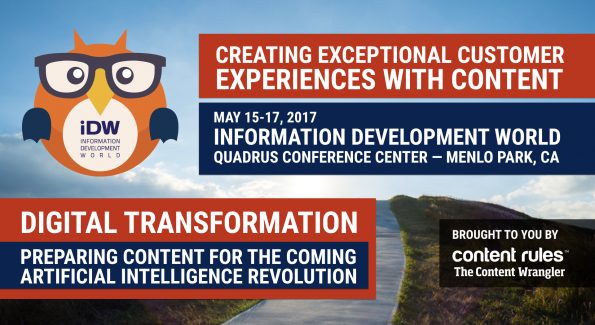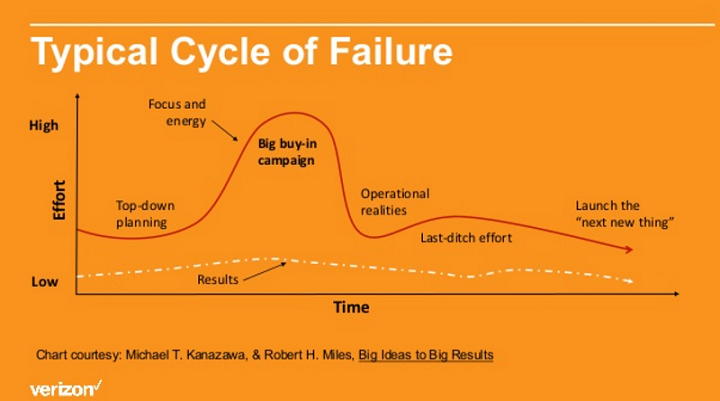Why Two Days of Information Development World Left Me in Information Nirvana (Part 1)
A group of men and one woman began designing the layout of a gynecological examination room on the ground floor of a medical building. The men suggested an open room concept with floor-to-ceiling windows, allowing plenty of natural light into the room, accented with blinds. Upon completing the initial concept, the men thought they’d conceived a brilliant floor plan. The sole woman designer on the team tried to persuade them otherwise. After her input was ignored, and as the plans approached finalization, the woman managed to challenge the men’s perspective by suggesting that prostate exams might also be performed in the room. No longer did huge windows, natural light and blinds seem like such a good idea! So began Mirhonda Studevant’s (@okKMchef) twenty-five minute Information Development World presentation, one of the most compelling talks on empathy in content I have ever heard. (More on that in Part 2 of this blog.)
Getting Over My Initial Skepticism
For a seasoned practitioner, conferences can often present the same-old, same-old. When I attended Information Development World a few weeks ago I admit I was skeptical that I’d gain much value from the experience. The fact that speakers were allocated 25 minutes per talk left me even more dubious.
Frankly, I can’t stand canned presentations, or talks where folks merely self-promote, or PowerPoints that offer lots of pictures of animals and remedial ‘wow’ moments that could be manufactured in the first ten minutes of a 101 course on any given topic.
I could not have been more wrong in my initial skepticism. Information Development World blew me away. Each talk completely mollified my suspicions. I was not only spellbound, my mind was left racing, hoping to catalogue each word, slide, and sentiment. Full disclosure here, I attended the first two days and missed the third. (And I very much regret missing that third day!) But those first two days filled my mind with so much information that I left intellectually exhausted and happily inspired. The conference was amazing, and afterwards I wanted to go out and do incredible work, and write and think about how I could apply what I had learned. It reminded me how of how exciting the industry I work in is, and it made me want to do better within that industry. As a practitioner and leader with over 20 years-experience, inspiration for me is a savored moment, and each minute of this conference offered that.
Why Information Development World was Structured for Success
The event was structured around a series of tracks, which could more appropriately be described as learning modules. Each track had three sections—an introduction to the topic, then theory around it or how-to and then a specific aspect of the topic. For example, the track on design thinking with three presentations was structured as follows:
- What is Design Thinking
- Design Thinking for Content
- Design Thinking and Doing
The first day contained four tracks: Digital Transformation, Design Thinking, The Customer Journey, and Creating Engagement. Since previous to the event the speakers within each track met and discussed their presentations as they pulled their talks together, there was cohesiveness, consistency, and a lack of redundancy. The speakers were top notch and well-prepared. A twenty-five minute time frame required that they stayed on point and made each point matter, an aspect of which I was very aware, since I presented a talk on content mapping for customer journeys.
The audience weighted more to the management and senior levels, but I also met several practitioners. We sat in a room from 9:00 a.m. until 5:00 p.m. hearing one presentation after another, with two coffee and cake breaks, a lovely lunch, and wine and charcuterie at the end of the day. The Qaudrus center in Menlo Park presents a captivating space, as it should since it is sited above Stanford University.
Key Takeaways From the Event
I won’t speak to every presentation, but highlights of each track are summed up below.
Lisa Trager (@Lisalt) of Verizon spoke about operational readiness to embrace digital transformation. Some key takeaways included:
- Change causes cognitive overload and lowers proficiency. People need encouragement and support during the process.
- The typical lifecycle of failure within organizations is to try continuously to excite people for change, a failure to deliver upon it, whilst disrupting productivity, without any resulting gain and then, a reinvigorated push about the ‘next best thing’ as the initial idea fails.
- Change requires a strategy with measurable objectives, a “we” approach and firmness, clarity, and compassion.
Lisa provided one of my favorite quotes from the event: “Just like Yoga and intention: to deal with organizational change, you first need to define your problem.”
Michelle Killebrew (@shellkillebrew) of Nomiku provided an excellent presentation on design thinking that demonstrated the relationship between design thinking and content ideation. Her thoughts included: “Personas create a three-dimensional person with whom to empathize.” She showed a nautilus shape as way to convey a design thinking model and urged the audience to think beyond convention: “Wild ideas encouraged!” She also spoke to the importance of empathy in the customer experience: “Empathy drives innovation. Focus on the user, not whims of the creator.”
Leon Segal (@lean_segal) of Innovationship, LLC provided guidance beneficial to anyone within a team. With wisdom gained from years of experience, including his time at IDEO, he offered such insights as: “In a great brainstorming session, you cannot track back to who[m] the original idea came from – it’s collaborative” He also offered that “Ideas are stories. EVERY idea shares a little story…share and learn to listen…listen[ing] is a lost art in our culture.” Finally, he proffered: “Be co-creative with people as you walk forward and innovate.” The underlying theme of his presentation was simple: “Everything you do has an impact upon someone.”
My track on Customer Journey included Adam Helweh (@secretsushi) of Secret Sushi defining a customer journey, and offering such wisdom as: “connected consumers are in the driver’s seat of their buyer’s journey.” He also spoke of its importance and role in contemporary businesses, along with key challenges. I spoke on how to map content to a customer journey. (Starting on June 21, you can listen a version of both of our talks here: https://www.brighttalk.com/webcast/9273/263215.) Joe Gelb (@joe_gelb) of Zoomin Software completed this track by providing the role of taxonomy and metadata in customer journeys, offering: “Taxonomy helps us profile.”
Gavin Austin (@GavinAustin) of Salesforce gave an excellent talk on making content engaging and interesting, especially technical content. His insights included: “Ways to keep tech content compelling: contests, weird projects, variety of subjects.” And: “Want to engage customers? Keep your prose playful, snappy, and to the point.”
Mark Protus (@markprotus) of Microsoft finished Day One with a flash talk that lasted only minutes by providing such insights on storytelling as: “humor is much more difficult than you think.” He opined that “We are all storytellers: Challenges to do so: cloud-based world, production lifecycles, multiple devices, and shifting time.”
Although I have not mentioned all the presenters, the above provides a taste of what we experienced in eight hours of our first day. In my next blog, I’ll offer some key presentations from Day Two and my final thoughts on the event. In the meantime, you can find all the slides from the event posted here: https://www.slideshare.net/InfoDevWorld.



Comments are closed